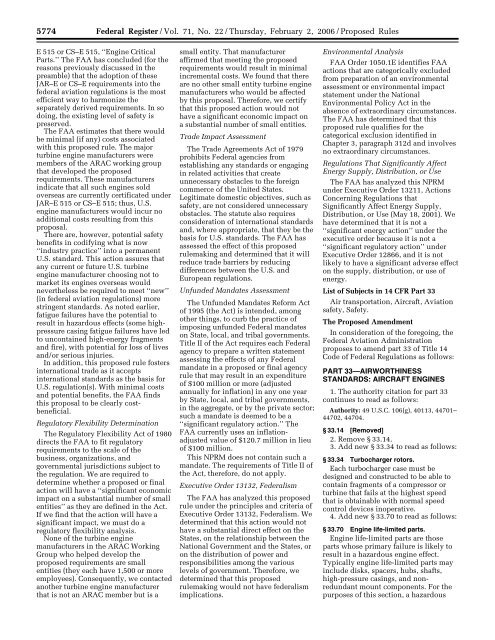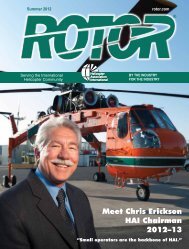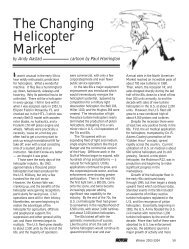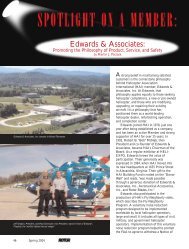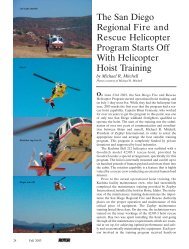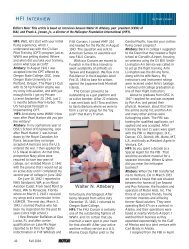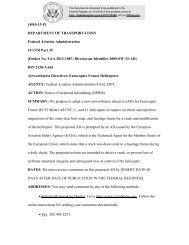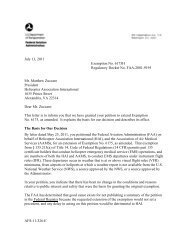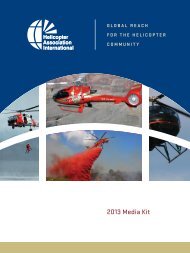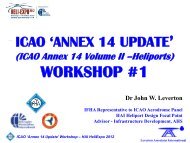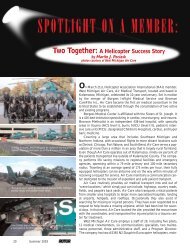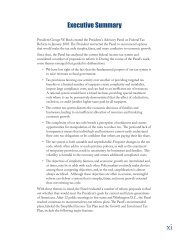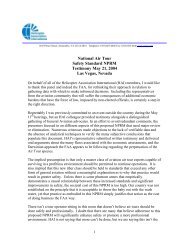Notice of Proposed Rulemaking - Helicopter Association International
Notice of Proposed Rulemaking - Helicopter Association International
Notice of Proposed Rulemaking - Helicopter Association International
You also want an ePaper? Increase the reach of your titles
YUMPU automatically turns print PDFs into web optimized ePapers that Google loves.
5774 Federal Register / Vol. 71, No. 22 / Thursday, February 2, 2006 / <strong>Proposed</strong> Rules<br />
wwhite on PROD1PC65 with PROPOSAL2<br />
E 515 or CS–E 515, ‘‘Engine Critical<br />
Parts.’’ The FAA has concluded (for the<br />
reasons previously discussed in the<br />
preamble) that the adoption <strong>of</strong> these<br />
JAR–E or CS–E requirements into the<br />
federal aviation regulations is the most<br />
efficient way to harmonize the<br />
separately derived requirements. In so<br />
doing, the existing level <strong>of</strong> safety is<br />
preserved.<br />
The FAA estimates that there would<br />
be minimal (if any) costs associated<br />
with this proposed rule. The major<br />
turbine engine manufacturers were<br />
members <strong>of</strong> the ARAC working group<br />
that developed the proposed<br />
requirements. These manufacturers<br />
indicate that all such engines sold<br />
overseas are currently certificated under<br />
JAR–E 515 or CS–E 515; thus, U.S.<br />
engine manufacturers would incur no<br />
additional costs resulting from this<br />
proposal.<br />
There are, however, potential safety<br />
benefits in codifying what is now<br />
‘‘industry practice’’ into a permanent<br />
U.S. standard. This action assures that<br />
any current or future U.S. turbine<br />
engine manufacturer choosing not to<br />
market its engines overseas would<br />
nevertheless be required to meet ‘‘new’’<br />
(in federal aviation regulations) more<br />
stringent standards. As noted earlier,<br />
fatigue failures have the potential to<br />
result in hazardous effects (some highpressure<br />
casing fatigue failures have led<br />
to uncontained high-energy fragments<br />
and fire), with potential for loss <strong>of</strong> lives<br />
and/or serious injuries.<br />
In addition, this proposed rule fosters<br />
international trade as it accepts<br />
international standards as the basis for<br />
U.S. regulation(s). With minimal costs<br />
and potential benefits, the FAA finds<br />
this proposal to be clearly costbeneficial.<br />
Regulatory Flexibility Determination<br />
The Regulatory Flexibility Act <strong>of</strong> 1980<br />
directs the FAA to fit regulatory<br />
requirements to the scale <strong>of</strong> the<br />
business, organizations, and<br />
governmental jurisdictions subject to<br />
the regulation. We are required to<br />
determine whether a proposed or final<br />
action will have a ‘‘significant economic<br />
impact on a substantial number <strong>of</strong> small<br />
entities’’ as they are defined in the Act.<br />
If we find that the action will have a<br />
significant impact, we must do a<br />
regulatory flexibility analysis.<br />
None <strong>of</strong> the turbine engine<br />
manufacturers in the ARAC Working<br />
Group who helped develop the<br />
proposed requirements are small<br />
entities (they each have 1,500 or more<br />
employees). Consequently, we contacted<br />
another turbine engine manufacturer<br />
that is not an ARAC member but is a<br />
small entity. That manufacturer<br />
affirmed that meeting the proposed<br />
requirements would result in minimal<br />
incremental costs. We found that there<br />
are no other small entity turbine engine<br />
manufacturers who would be affected<br />
by this proposal. Therefore, we certify<br />
that this proposed action would not<br />
have a significant economic impact on<br />
a substantial number <strong>of</strong> small entities.<br />
Trade Impact Assessment<br />
The Trade Agreements Act <strong>of</strong> 1979<br />
prohibits Federal agencies from<br />
establishing any standards or engaging<br />
in related activities that create<br />
unnecessary obstacles to the foreign<br />
commerce <strong>of</strong> the United States.<br />
Legitimate domestic objectives, such as<br />
safety, are not considered unnecessary<br />
obstacles. The statute also requires<br />
consideration <strong>of</strong> international standards<br />
and, where appropriate, that they be the<br />
basis for U.S. standards. The FAA has<br />
assessed the effect <strong>of</strong> this proposed<br />
rulemaking and determined that it will<br />
reduce trade barriers by reducing<br />
differences between the U.S. and<br />
European regulations.<br />
Unfunded Mandates Assessment<br />
The Unfunded Mandates Reform Act<br />
<strong>of</strong> 1995 (the Act) is intended, among<br />
other things, to curb the practice <strong>of</strong><br />
imposing unfunded Federal mandates<br />
on State, local, and tribal governments.<br />
Title II <strong>of</strong> the Act requires each Federal<br />
agency to prepare a written statement<br />
assessing the effects <strong>of</strong> any Federal<br />
mandate in a proposed or final agency<br />
rule that may result in an expenditure<br />
<strong>of</strong> $100 million or more (adjusted<br />
annually for inflation) in any one year<br />
by State, local, and tribal governments,<br />
in the aggregate, or by the private sector;<br />
such a mandate is deemed to be a<br />
‘‘significant regulatory action.’’ The<br />
FAA currently uses an inflationadjusted<br />
value <strong>of</strong> $120.7 million in lieu<br />
<strong>of</strong> $100 million.<br />
This NPRM does not contain such a<br />
mandate. The requirements <strong>of</strong> Title II <strong>of</strong><br />
the Act, therefore, do not apply.<br />
Executive Order 13132, Federalism<br />
The FAA has analyzed this proposed<br />
rule under the principles and criteria <strong>of</strong><br />
Executive Order 13132, Federalism. We<br />
determined that this action would not<br />
have a substantial direct effect on the<br />
States, on the relationship between the<br />
National Government and the States, or<br />
on the distribution <strong>of</strong> power and<br />
responsibilities among the various<br />
levels <strong>of</strong> government. Therefore, we<br />
determined that this proposed<br />
rulemaking would not have federalism<br />
implications.<br />
VerDate Aug2005 16:50 Feb 01, 2006 Jkt 208001 PO 00000 Frm 00006 Fmt 4701 Sfmt 4702 E:\FR\FM\02FEP2.SGM 02FEP2<br />
Environmental Analysis<br />
FAA Order 1050.1E identifies FAA<br />
actions that are categorically excluded<br />
from preparation <strong>of</strong> an environmental<br />
assessment or environmental impact<br />
statement under the National<br />
Environmental Policy Act in the<br />
absence <strong>of</strong> extraordinary circumstances.<br />
The FAA has determined that this<br />
proposed rule qualifies for the<br />
categorical exclusion identified in<br />
Chapter 3, paragraph 312d and involves<br />
no extraordinary circumstances.<br />
Regulations That Significantly Affect<br />
Energy Supply, Distribution, or Use<br />
The FAA has analyzed this NPRM<br />
under Executive Order 13211, Actions<br />
Concerning Regulations that<br />
Significantly Affect Energy Supply,<br />
Distribution, or Use (May 18, 2001). We<br />
have determined that it is not a<br />
‘‘significant energy action’’ under the<br />
executive order because it is not a<br />
‘‘significant regulatory action’’ under<br />
Executive Order 12866, and it is not<br />
likely to have a significant adverse effect<br />
on the supply, distribution, or use <strong>of</strong><br />
energy.<br />
List <strong>of</strong> Subjects in 14 CFR Part 33<br />
Air transportation, Aircraft, Aviation<br />
safety, Safety.<br />
The <strong>Proposed</strong> Amendment<br />
In consideration <strong>of</strong> the foregoing, the<br />
Federal Aviation Administration<br />
proposes to amend part 33 <strong>of</strong> Title 14<br />
Code <strong>of</strong> Federal Regulations as follows:<br />
PART 33—AIRWORTHINESS<br />
STANDARDS: AIRCRAFT ENGINES<br />
1. The authority citation for part 33<br />
continues to read as follows:<br />
Authority: 49 U.S.C. 106(g), 40113, 44701–<br />
44702, 44704.<br />
§ 33.14 [Removed]<br />
2. Remove § 33.14.<br />
3. Add new § 33.34 to read as follows:<br />
§ 33.34 Turbocharger rotors.<br />
Each turbocharger case must be<br />
designed and constructed to be able to<br />
contain fragments <strong>of</strong> a compressor or<br />
turbine that fails at the highest speed<br />
that is obtainable with normal speed<br />
control devices inoperative.<br />
4. Add new § 33.70 to read as follows:<br />
§ 33.70 Engine life-limited parts.<br />
Engine life-limited parts are those<br />
parts whose primary failure is likely to<br />
result in a hazardous engine effect.<br />
Typically engine life-limited parts may<br />
include disks, spacers, hubs, shafts,<br />
high-pressure casings, and nonredundant<br />
mount components. For the<br />
purposes <strong>of</strong> this section, a hazardous


